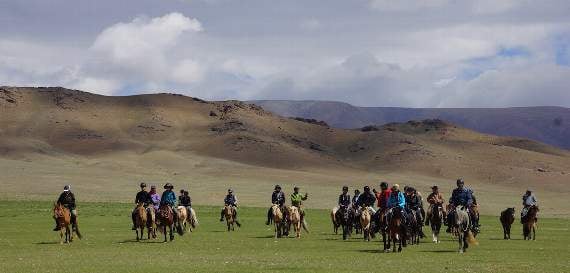THE former Commanding Officer of the Royal Monmouth Royal Engineers has just returned from an adventurous expedition to Mongolia, searching for the rare Przewalski‘s horse.
Col Paul Lodge of Llangrove joined the successful scientific and community aid expedition, led by explorer Colonel John Blashford-Snell OBE, as his second in command.
The team of 24 international self-funded volunteers enjoyed seeing the rare Przewalski’s horse and endangered Saiga Antelope. The team were riding local horses and travelled miles in order to view the remarkable palaeolithic era rock paintings, bronze age burials and wide range of plants, birds and mammals. The team recorded 59 bird species, 19 mammal species and no less than 89 vertebrate species.
As well as the scientific work, the community aid undertaken included dentistry and medical work and distribution of reading glasses and gifting books, dolls and puppets to children.
The Przewalski’s horse was discovered by Russian Army Colonel Nikolai Przewalski in 1878. These stocky ancestors of the modern horse were hunted down and distributed to zoos around the world, and by 1968 they were extinct in Mongolia; however through careful reintroduction from an original stock of only a dozen held in international zoos, the population now exceeds 400.
Paul said: “Our zoological director, Professor Terbish of the National University, reckoned we might have a glimpse of the Takhi, as they are known, watering at the Tariat stream that winds its way through steppe and birch forests of the Hustai National Park rising to 1843m above the broad Tuul river.
“We were lucky and soon saw a dozen or so of the pale coated horses browsing quietly on the hill sides. Then rounding a bend in the trail was the sight we shall not forget.
“Along the meandering stream and on the slopes above it were over 50 Przewalskis. Mares with foals were being shepherded by their guardian stallion, who kept trotting back to chase off young bachelors eager to reach his harem. Others bathed in the dark waters whilst several rolled in the dust to protect themselves from ectoparasites and insects. Some groomed each other, but with much whinnying, kicking and biting a number of stallions fought as they attempted to win control of their own mares.
“Parading across our front, they paid little attention to our team that could approach within fifty metres; a photographer’s paradise and a remarkable sight which few will forget.
“This was in the closing stage of our expedition that had begun on 6th July with the arrival of our twenty-four international members in the rapidly growing city of Ulaan Baatar, where modern skyscrapers tower above ancient Buddhist temples and converted communist era apartment blocks echo to the roar of the modern traffic.”

Comments
This article has no comments yet. Be the first to leave a comment.